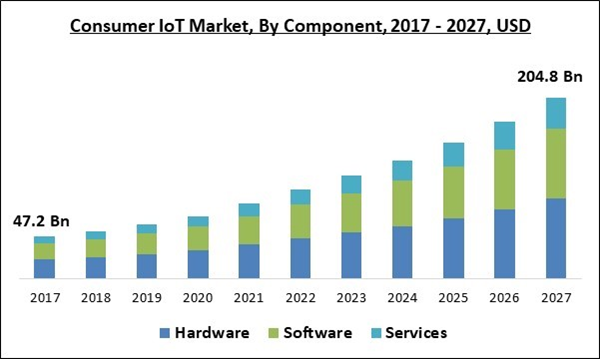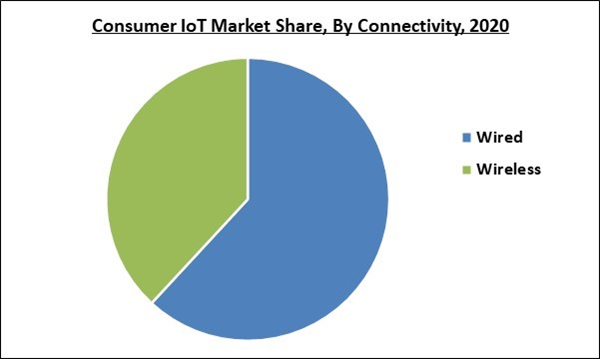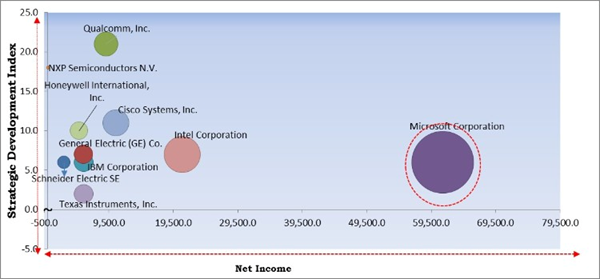The Global Consumer IoT Market size is expected to reach $204.8 billion by 2027, rising at a market growth of 15.9% CAGR during the forecast period.
IoT refers to a network that comprises internet-connected objects. These objects can gather and exchange data with the help of sensors integrated within them. IoT systems are capable of connecting together specialized devices that are developed for particular purposes with a restricted degree of programmability and customizability. In addition, IoT systems can store and process data in a distributed manner.
The Consumer Internet of Things consists of a broad array of consumer categories, including fitness, automobiles, healthcare, and the home. As the number of smartwatches, earbuds, and televisions is increasing in the last couple of years, which further supports level miniaturizations, higher sensor accuracy, and data analysis creating opportunities for connected medical accessories.
COVID-19 Impact Analysis
The electronics and semiconductor sectors have been severely impacted by the outbreak of the global pandemic. Business and manufacturing facilities across numerous nations were closed due to the rising number of COVID-19 cases and is expected to remain closed in 2021. In addition, the global supply chain has been severely disrupted by the partial or complete lockdown, thus creating challenges for the manufactures to outreach customers.
Moreover, the Asian and European nations under the lockdowns have experienced a significant decline in business and revenue because of the closure of manufacturing facilities. The outbreak of the COVID-19 pandemic has severely impacted the operations of the production and manufacturing industries, which further impacted the development of the consumer IoT market. A significant impact includes a large manufacturing disruption across Europe and a severe disruption in Chinese parts exports, which could hamper the growth of the consumer IoT market.
Market Growth Factors:
High penetration to boost the market growth
The faster internet connectivity technology enables consumers to use connected devices in a better and easy way, thus boosting the market growth during the forecasting period. In addition, internet connectivity technology facilitates connected devices to better transfer and cross-reference data, collect performance data of employees, and offer marketing products efficiently. In addition, internet of things technology is utilized in various connected devices of many industries like aviation, agriculture, manufacturing, logistics, healthcare, and several other industries, helping them to collect and organize the data from several data streams and organize it effectively.
Healthcare, BFSI, and education industries are increasingly adopting connected devices
The growth of the overall consumer IoT market is expected to be driven by the growing adoption of connected healthcare devices like remote monitoring equipment and heart-rate monitoring device among healthcare experts. In addition, connected medical devices are of paramount importance for healthcare experts to focus on high-priority tasks and active patient engagement and provide patient-oriented care delivery services. Therefore, these services require fast-speed internet connectivity among healthcare professionals and doctors, thereby propelling the growth and demand for the consumer IoT market.
Marketing Restraining Factor:
Absence of skilled workforce
Skilled employees are needed to manage the new software systems to install AI-based IoT technologies and skillsets. Thus, the current workforce should be imparted training regarding how to operate the latest and advanced systems. Industrial verticals are dynamic toward embracing the latest technologies; though, they are witnessing less availability of well-trained and proficient workers. As the majority of the key market players are harnessing the potential of IoT solutions, thereby propelling the demand for extremely trained workers.
Vertical Outlook
Based on the Vertical, the Consumer IoT market is divided into Home Automation, Consumer Electronics, Automotive, Healthcare, and Others. The home Automation segment is expected to obtain the highest revenue share of the market during the forecasting period. With the rise in penetration of high-speed internet, there has been increased adoption of connected devices and smart home applications particularly in regions like North America, Europe, and Asia-pacific.
Regional Outlook
Based on the Region, the Consumer IoT market is analyzed across North America, Europe, APAC, and LAMEA. In 2020, North America emerged as the leading region in the overall consumer IoT market. In addition, the regional market is expected to showcase a promising growth rate during the forecast period. Factor such as the thriving consumer electronics sector is responsible for the growth of this region.
Cardinal Matrix - Consumer IoT Market Competition Analysis
The major strategies followed by the market participants are Partnerships. Based on the Analysis presented in the Cardinal matrix; Microsoft Corporation is the major forerunners in the Consumer IoT Market. Companies such as Texas Instruments, Inc., Intel Corporation, and Qualcomm, Inc. are some of the key innovators in Consumer IoT Market.
The market research report covers the analysis of key stake holders of the market. Key companies profiled in the report include Microsoft Corporation, IBM Corporation, Schneider Electric SE, General Electric (GE) Co., Cisco Systems, Inc., NXP Semiconductors N.V., Texas Instruments, Inc., Intel Corporation, Qualcomm, Inc., and Honeywell International, Inc.
Recent Strategies Deployed in Consumer IoT Market
Partnerships, Collaborations and Agreements:
- Sep-2021: IBM joined hands with Airspan Networks, an American telecommunications company. Through this collaboration, the company aimed to introduce a 5G-enabled Open RAN testbed across the IBM Watson Center Germany and IBM’s Global Industry Solution Center (GISC) in Nice, France, to display long-distance dominance over 5G-enabled edge computing.
- Aug-2021: Cisco partnered with AT&T, an American multinational conglomerate. The partnership aimed to drive the performance of IoT applications with superior 5G network capabilities. Moreover, the partnership is expected to help AT&T Control Center customers to leverage the potential of 5G to connect industrial and business-critical devices for extreme IoT visibility.
- Aug-2021: GE Appliances signed a multi-year partnership with Google Cloud. This partnership aimed to develop the next generation of smart home technologies. Through this partnership, the two companies is expected to integrate their expertise, GE appliances in hardware and Google Cloud in data, artificial intelligence, machine learning, and analytics in order to offer new smart home technologies and enhanced experiences.
- Jul-2021: Qualcomm teamed up with Capgemini, a French multinational information technology services and consulting company. Through this collaboration, the companies aimed to unleash the advantages of 5G private networks to accelerate the customers' digital transformation towards Intelligent Industry.
- Jul-2021: Texas instruments joined hands with B-Secur, a biometrics company that produces a wearable device, Heartkey. The collaboration aimed to offer Powerful, Medical-Grade ECG/EKG Monitoring for Consumer Wearable Devices. Through this collaboration, the two companies is expected to provide high-performing sensing capabilities for wearable equipment such as premium smartwatches and Wi-Fi-connected optical heart-rate monitors, and allow advanced features for identification, wellness, and health monitoring in the Internet of Things (IoT) devices.
- Jun-2021: Cisco teamed up with Vodafone Idea, India's leading telecom operator. The collaboration aimed to streamline and automate its network to support 4G and, in the future, 5G use cases, and provide a superior experience for its consumer, retail, and enterprise customers.
- Jun-2021: NXP Semiconductors joined hands with Jio Platforms, a subsidiary of RIL. Through this collaboration, the two companies is expected to deploy a 5G NR O-RAN small cell solution that embeds NXP’s Layerscape family of multicore processors.
- May-2021: Intel came into a partnership with Disrupt-X, a Dubai-based IoT Development Company. Through this partnership, the two companies launched Ignite Shield at a worldwide level. Moreover, Ignite Shield is the First Water and Air Quality Monitoring IoT Platform in the World.
- Mar-2021: Microsoft signed an agreement with Nokia, a Finnish multinational telecommunications, information technology, and consumer electronics company. Through this partnership, the two companies is expected to develop new market-ready 4G and 5G private wireless use cases created for enterprises. The collaboration is expected to integrate the Cloud RAN (vRAN) technologies of Nokia with Microsoft Azure cloud-based services and developer ecosystem to boost end-user functionality through new business cases.
- Feb-2021: Honeywell came into a partnership with IDEMIA, the global leader in Augmented Identity. The partnership aimed to develop solutions that is expected to enable occupants to effortlessly and safely have contactless engagement with a building from vehicle recognition at the car park and automatic elevator calls to biometric-based access and tailored conference room settings.
- Dec-2020: Honeywell entered into a partnership with Signify, the world leader in lighting. Through this partnership, the companies is expected to install integrated, smart lighting solutions for commercial buildings. Moreover, the partnership is expected to enhance the occupant experience by focusing on productivity and well-being to bring down energy consumption.
- Dec-2020: IBM collaborated with Samsung Electronics, a South Korean multinational electronics corporation. Through this collaboration, the two companies is expected to design edge computing, 5G, and hybrid cloud solutions. Moreover, the collaboration aimed to offer companies with latest solutions for mobile edge computing and end-to-end private 5G networks which run on open architecture and enable workers with the help of 5G-enabled Samsung Galaxy devices.
- Oct-2020: Microsoft came into a partnership with SoftBank-owned UK chipmaker Arm. The partnership aimed to develop Azure-based tools to allow developers to foward data from Arm-based Internet of Things (IoT) devices to Azure Cloud. Moreover, the partnership is expected to allow developers to easily target a wide array of Arm-based devices such as intelligent computer-vision-enabled cameras, AI gateways, connected vehicles, and intelligent appliances.
- Feb-2020: Honeywell teamed up with Bigfinite, an artificial intelligence (AI) and advanced analytics Platform Company. The partnership aimed to offer advanced solutions and platforms for the life sciences industry. Through this partnership, the cloud-based Software-as-a-Service (SaaS) platform of Bigfinite and advanced process automation and visualization of Honeywell offer real-time visibility and predictive insights with the help of advanced analytics, artificial intelligence, and Internet-of-Things (IoT) technologies with end-to-end data integrity.
Acquisitions and Mergers:
- Jul-2020: Cisco acquired Fluidmesh Networks, a leader in resilient wireless backhaul systems. Through this acquisition, Cisco expanded its industrial wireless offerings to industries with on-the-move assets and mission-critical applications in situations where zero data loss is crucial for uptime and business resiliency.
Product Launches and Product Expansions:
- Nov-2021: NXP launched the newest addition to their system-on-module (SOM) suite, the Summit SOM 8M Plus. The Summit SOM 8M Plus is an extremely-integrated and full-featured hardware and software solution that integrates multi-core applications processing of NXP with NXP dual-band 2x2 Wi-Fi 5 and Bluetooth 5.3 connectivity for a wide array of next-generation IoT applications.
- Nov-2021: NXP Semiconductors launched i.MX 93 family of applications processors. The latest processors are developed for automotive, smart building, smart home, and smart factory applications, which harness edge machine learning to expect and automate on the basis of the requirements of users.
- Oct-2021: Schneider Electric introduced the next generation of EcoStruxure Power, its flagship power distribution system. This full-featured IoT-enabled architecture and platform are developed to digitize and streamline electrical distribution infrastructure, offering trusted “always-on” power for commercial buildings, data centers, healthcare, industry, and infrastructure.
- Jun-2021: Qualcomm Technologies launched seven new solutions viz. Qualcomm QCS8250, Qualcomm QCS4290/ QCM4290, Qualcomm QCS6490/ QCM6490, and the Qualcomm QCS2290/ QCM2290. Through this launch, the company aimed to offer support to the IoT ecosystem which is expected to assist allow the penetration of advanced IoT devices. These new IoT solutions from the company are made for a specific purpose to assist fulfill requirements of the thriving IoT ecosystem for key segments including transportation and logistics, video collaboration, warehousing, smart cameras, retail, healthcare, and more.
- Jun-2021: Cisco Meraki introduced expanded IoT and WAN offerings with advanced innovations to support hybrid workforces worldwide with more smart and secure workspace environments. Moreover, smarter analytics for small businesses and Real-time insights into environmental conditions are included in these new additions.
- May-2021: Qualcomm Technologies unveiled Qualcomm® 315 5G IoT Modem-RF System, a purpose-built Internet of Things (IoT) modem solution integrated with 5G connectivity and optimized for Industrial IoT (IIoT) applications. Through this launch, the company aimed to dominate the IoT landscape. Moreover, the new solution is a full-featured modem-to-antenna solution developed to complement the IoT ecosystem in creating upgradeable LTE and 5G devices for IoT verticals, boosting the adoption rate of 5G connectivity for IoT, and increasing the number of opportunities for 5G in the IoT industry.
- Feb-2021: NXP Semiconductors launched the latest new EdgeLock 2GO IoT service platform. This platform aims to facilitate easy, safe installation and management of IoT devices and services. The platform offers an extremely flexible approach to IoT security that safeguards edge devices connecting to services and keeps up edge device security throughout its complete lifecycle.
- Oct-2020: NXP Semiconductors rolled out a family of 2x2 Wi-Fi 6 (802.11ax) Dual-Band + Bluetooth/BLE solutions. These solutions are facilitating a new phase of connectivity innovation for next-generation gaming, audio, industrial and IoT markets.
- Sep-2020: Intel launched the latest and advanced internet of things (IoT) capabilities. The Intel Atom x6000E series, 11th Gen Intel Core processors, and Intel Pentium and Celeron N and J series have the latest artificial intelligence (AI), functional safety, security, and real-time capabilities to edge customers.
- Jul-2020: Qualcomm Technologies rolled out Qualcomm QCS610 and Qualcomm QCS410 system-on-chips (SoCs) to the Qualcomm Vision Intelligence Platform. These are developed to introduce premium camera technology such as powerful artificial intelligence and machine learning features earlier only available to premium devices, into mid-tier camera segments.
- Apr-2020: Qualcomm Technologies introduced Qualcomm 212 LTE IoT Modem, the world's most-efficient single-mode NB2 (NB-IoT) chipset. This new modem is expected to assist enter into a new era of IoT applications worldwide, particularly those needing connectivity deep within buildings integrated with low power use, like battery-powered IoT devices that require to operate for 15 years or longer in the field.
Scope of the Study
Market Segments Covered in the Report:
By Component
- Hardware
- Processors
- Network Infrastructure
- Sensors
- Others
- Software
- Services
By Connectivity
- Wired
- Wireless
By Vertical
- Home Automation
- Automotive
- Consumer Electronics
- Healthcare
- Others
By Geography
- North America
- US
- Canada
- Mexico
- Rest of North America
- Europe
- Germany
- UK
- France
- Russia
- Spain
- Italy
- Rest of Europe
- Asia Pacific
- China
- Japan
- India
- South Korea
- Singapore
- Malaysia
- Rest of Asia Pacific
- LAMEA
- Brazil
- Argentina
- UAE
- Saudi Arabia
- South Africa
- Nigeria
- Rest of LAMEA
Key Market Players
List of Companies Profiled in the Report:
- Microsoft Corporation
- IBM Corporation
- Schneider Electric SE
- General Electric (GE) Co.
- Cisco Systems, Inc.
- NXP Semiconductors N.V.
- Texas Instruments, Inc.
- Intel Corporation
- Qualcomm, Inc.
- Honeywell International, Inc.
Unique Offerings from the Publisher
- Exhaustive coverage
- The highest number of market tables and figures
- Subscription-based model available
- Guaranteed best price
- Assured post sales research support with 10% customization free
Table of Contents
Companies Mentioned
- Microsoft Corporation
- IBM Corporation
- Schneider Electric SE
- General Electric (GE) Co.
- Cisco Systems, Inc.
- NXP Semiconductors N.V.
- Texas Instruments, Inc.
- Intel Corporation
- Qualcomm, Inc.
- Honeywell International, Inc.
Methodology

LOADING...











